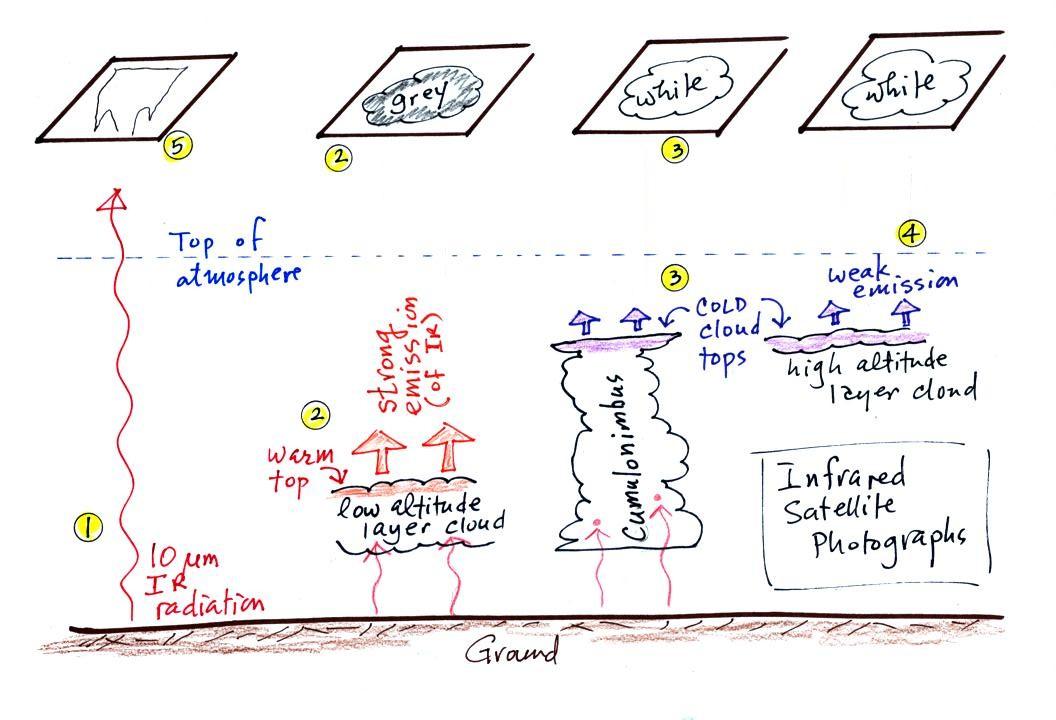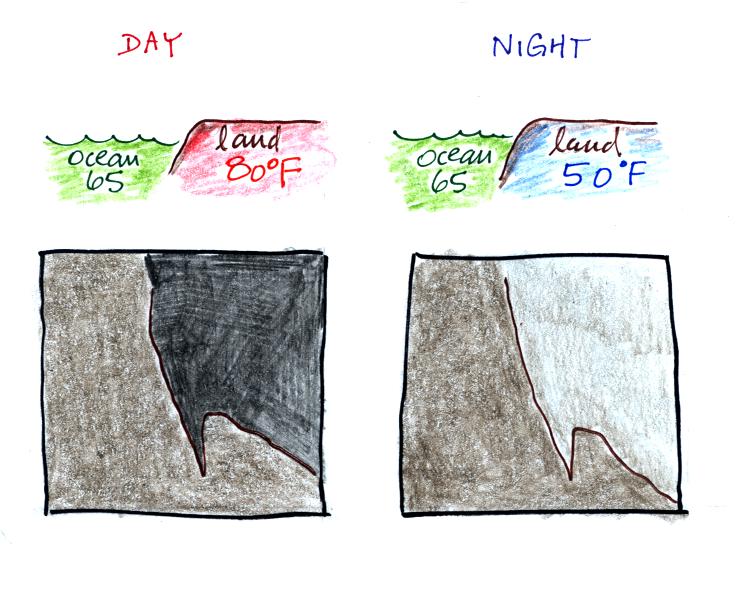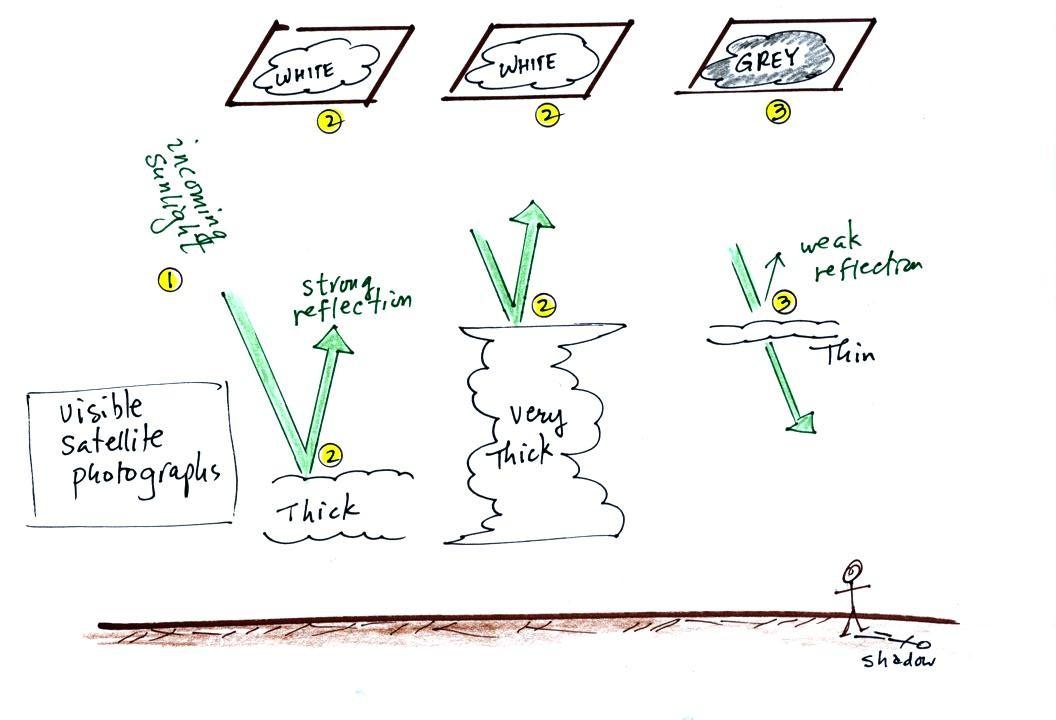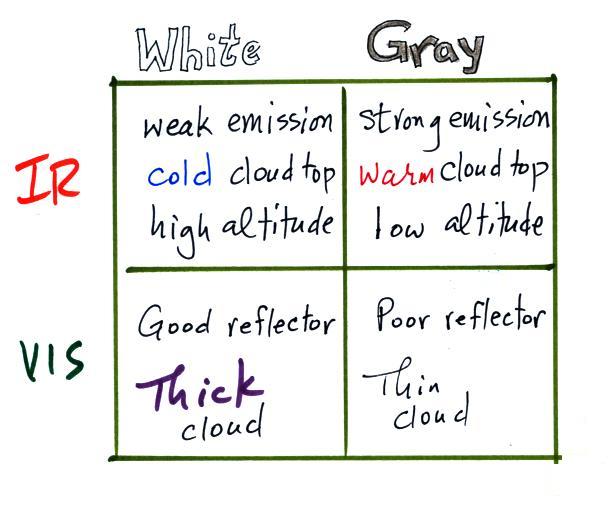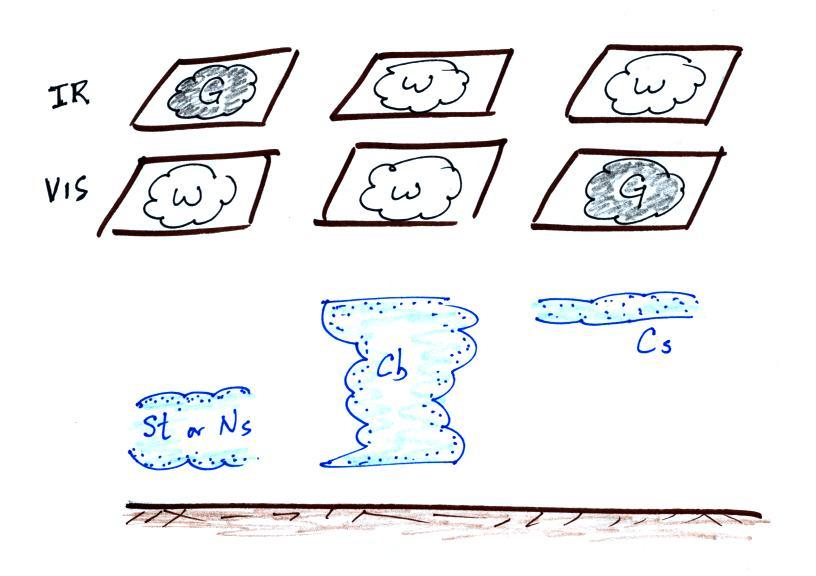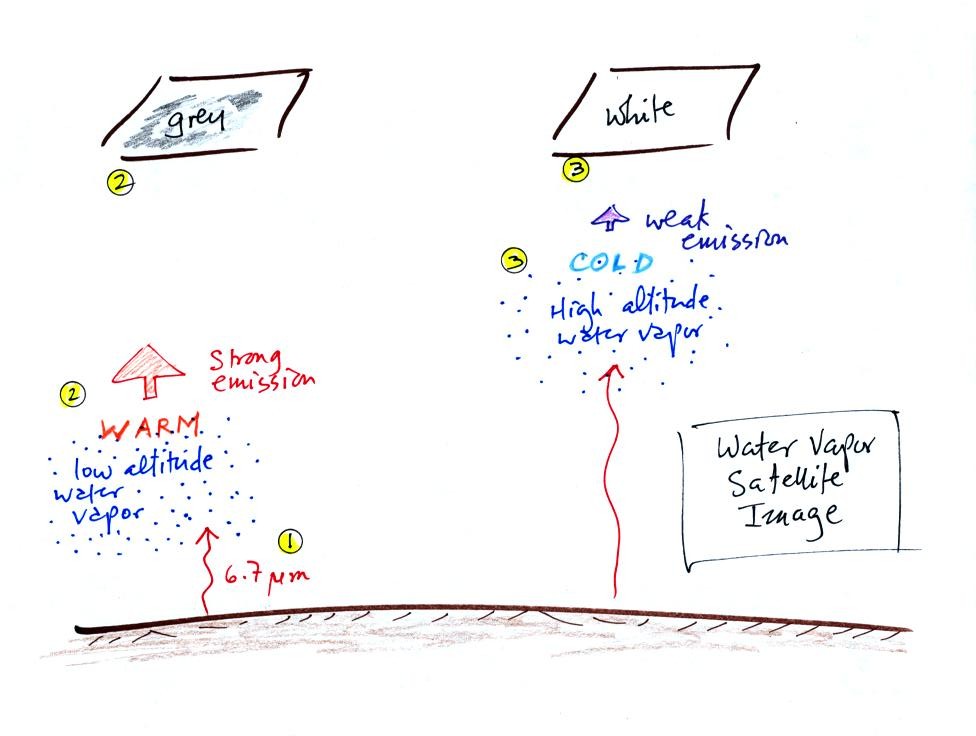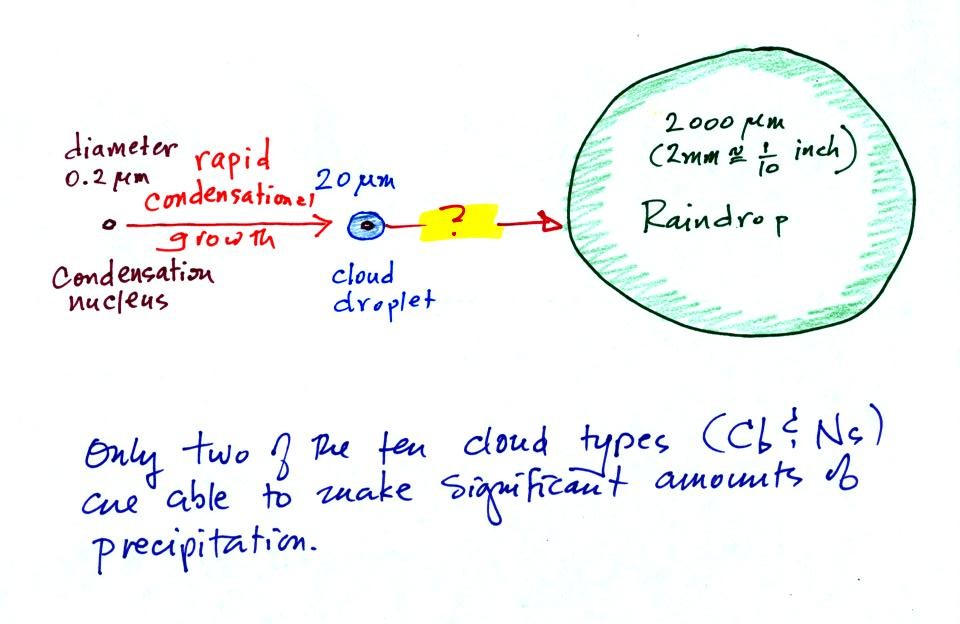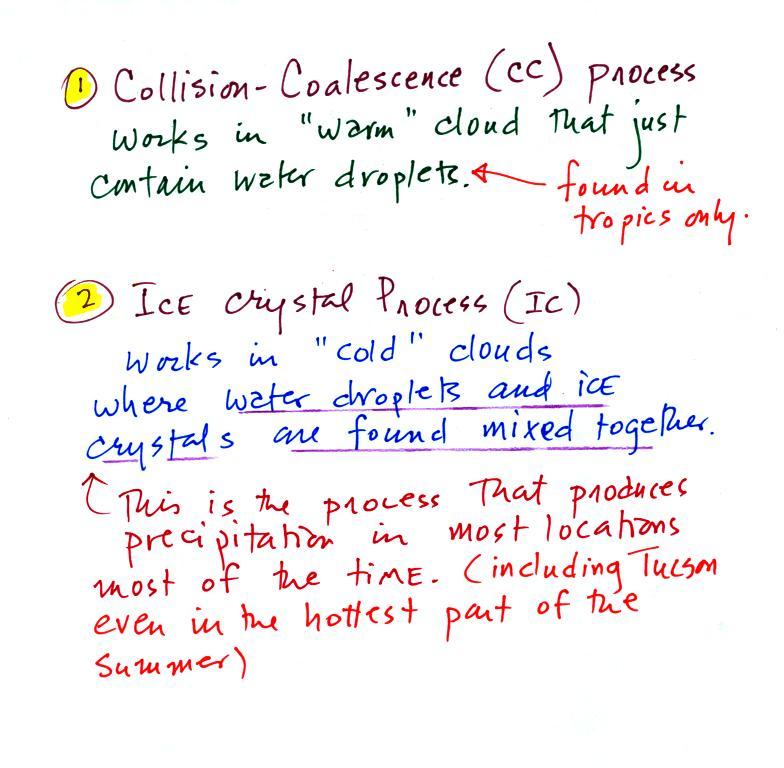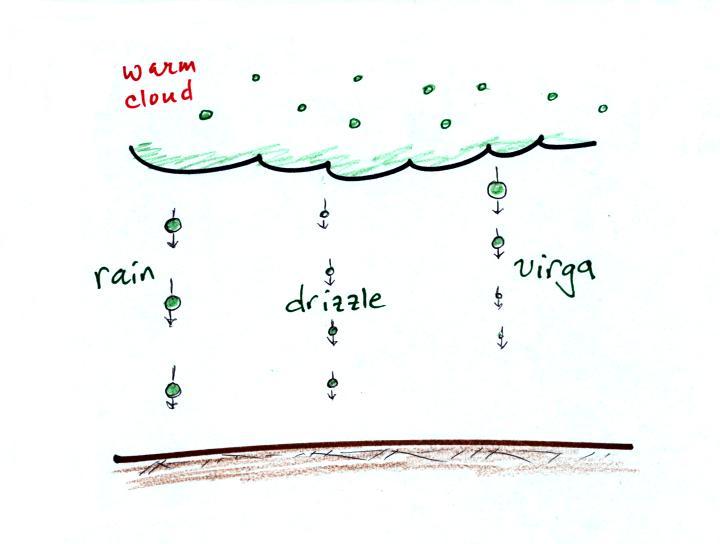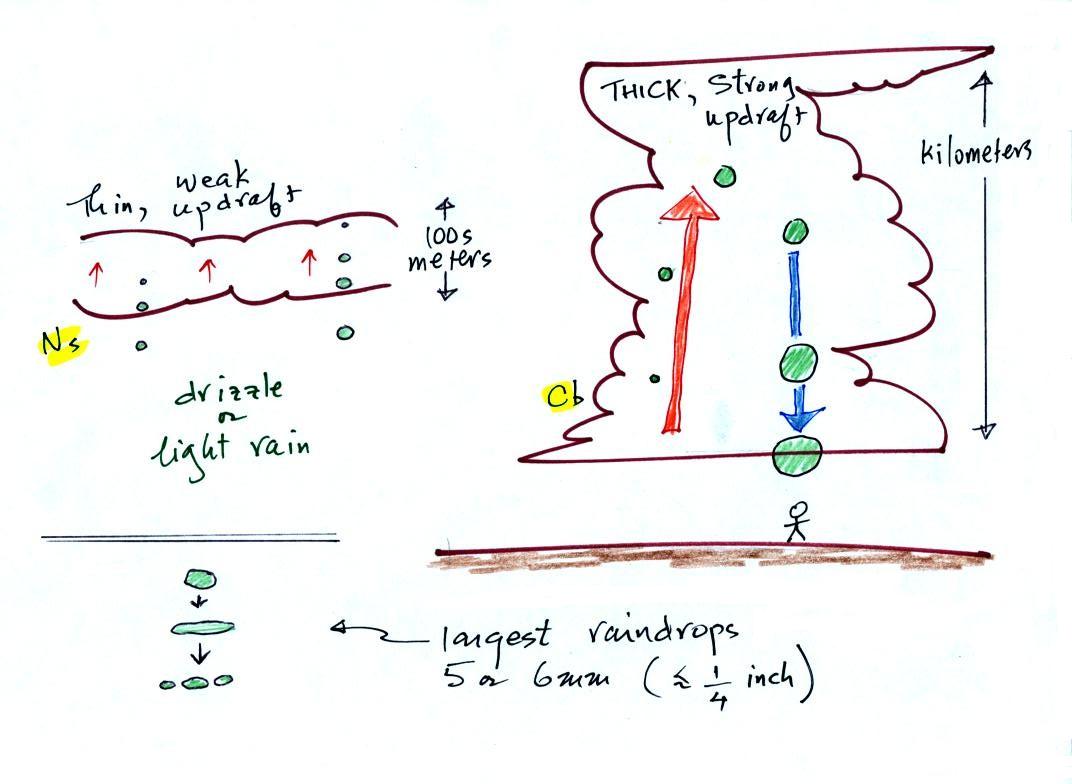Friday Mar. 29, 2013
click here to download today's notes
in a more printer friendly format
As promised a little gospel music before class: "This Little
Light of Mine" featuring Odetta and the Harlem Boy's Choir
and "Look
Where He Brought Me From" with the Five Blind Boys of
Alabama.
We spent the first 5 minutes or so of
class finishing up the information about features on thunderstorm
clouds(mammatus and shelf clouds) that we didn't quite have time
for on Wednesday. You'll find all of that stuck on the end
of Wednesday's notes.
After learning about clouds on Wednesday this seemed like a
logical place to briefly discuss the 2 most common types of
satellite photographs.
You'll find the following figures discussed on pps 99-100 in the
photocopied ClassNotes.
IR satellite photographs
When you see satellite photographs of clouds on the TV weather
you are probably seeing an infrared satellite photograph.
1.
An infrared satellite photograph detects the 10 μm
IR radiation actually emitted by the ground, the ocean and by
clouds. You don't depend on seeing reflected sunlight, so clouds can be
photographed during the day and at night, 24 hours per
day. You may recall that 10 μm radiation is in the middle of
the atmospheric window, so this radiation is able to pass through
air without being absorbed. If clouds don't get in the way,
you can see the ground and the ocean on an IR photograph.
2. Clouds do absorb 10 μm
radiation and then reemit 10 μm IR
radiation upwards toward the satellite and down toward the
ground. It is the radiation emitted by the top surface of
the cloud that will travel through the atmosphere and up to the
satellite. The top surface of a low altitude cloud will be
relatively warm. Warmer objects emit stronger IR radiation
than a cool object (the Stefan Boltzmann law). This is shown
as grey on an IR satellite photograph. A grey
unimpressive looking cloud on an IR satellite photograph may
actually be a thick nimbostratus cloud that is producing rain or
snow.
3. Cloud tops found at high altitude are cold and
emit IR radiation at a lower rate or lower intensity. This
shows up white on an IR photograph.
4. Two very different clouds (a thunderstorm and a
cirrostratus cloud) would both appear white on the satellite
photograph and would be difficult to distinguish.
Meteorologists are interested in locating thunderstorms because
they can produce hazardous severe weather. This can't be
done using just IR photographs.
5. The ground changes temperature during the course
of the day. On an infrared satellite animation you can watch
the ground change from dark grey or black (afternoon when the
ground is warmest) to lighter grey (early morning when the ground
is cold) during the course of a day. Because of water's high
specific heat, the ocean right alongside doesn't change
temperature much during the day and remains the same shade of grey
throughout the day.
Here's a
link to an IR satellite photograph loop on the UA
Atmospheric Sciences Dept. webpage.
Visible satellite photographs
1. A visible satellite photograph photographs sunlight that
is reflected by clouds. It shows what you would see if you
were out in space looking down at the earth. You won't see
clouds on a visible satellite photograph at night.
2. Thick clouds are good reflectors and appear white. The
low altitude layer cloud and the thunderstorm would both appear
white on this photograph and would be difficult to distinquish.
3. Thinner clouds don't reflect as much light and appear
grey.
Here's a summary
The figure below shows how if you
combine both visible and IR photographs you can begin to
distinguish between different types of clouds.
You can use this figure to answer the satellite
photograph question that is on the Quiz #3 Study Guide.
A student in class asked about a 3rd type of satellite
photograph, a water vapor image. Here is some information
about them that wasn't discussed in class.
This is also an IR satellite photograph, but the
satellite detects and photographs 6.7 μm
radiation. This type of image can show air motions in
regions where there aren't any clouds because the 6.7 um
radiation (Point 1) is absorbed by water vapor. The water
vapor then emits IR radiation upward toward the satellite where it
can be photographed. Water vapor from lower in
the atmosphere emits more strongly and appears grey (Point 2), water
vapor from high in the atmosphere emits weak radiation and appears
white (Point 3).
The last big topic we will cover
before next week's quiz is precipitation formation and types of
precipitation. Only two of the 10 main cloud types
(nimbostratus and cumulonimbus) are able to produce significant
amounts of precipitation. Why is that? Why is it so
hard for clouds to make precipitation?
This figure shows typical sizes of cloud condensation nuclei
(CCN), cloud droplets, and raindrops (a human hair is about 50 μm
thick for comparison). As we saw in the cloud in a bottle
demonstration it is relatively easy to make cloud
droplets. You cool moist air to the dew point and raise
the RH to 100%. Water vapor condenses pretty much
instantaneously onto a cloud condensation nucleus to form a
cloud droplet. It would take much longer (a day or more)
for condensation to turn a cloud droplet into a raindrop.
You know from personal experience that once a cloud forms you
don't have to wait that long for precipitation to begin to fall.
Part of the problem is that it
takes quite a few 20 μm diameter cloud
droplets to make one 2000 μm diameter
raindrop. How many exactly? Before answering that
question we will look at a cube (rather than a sphere).
How many sugar cubes would you
need to make a box that is 4 sugar cubes on a side?
It would take 16 sugar cubes to make each layer and there are 4
layers. So you'd need 64 sugar cubes. Volume is
length x width x height.
The raindrop is 100 times wider, 100 times deeper, and 100
times taller than the cloud droplet. The raindrop has a
volume that is 100 x 100 x 100 = 1,000,000 (one million) times
larger than the volume of the cloud droplets. It
takes about a million cloud droplets to make one average size
raindrop.
Fortunately
there
are
two
processes
capable
of
quickly
turning
small
cloud
droplets into much larger precipitation particles in a cloud.
The collision coalescence process works in clouds that
are composed of water droplets only. Clouds like this are
only found in the tropics. We'll see that this is a pretty
easy process to understand.
This process will only produce rain, drizzle, and something
called virga (rain that evaporates before reaching the ground).
The ice crystal process produces precipitation everywhere
else. This is the process that makes rain in Tucson, even on
the hottest day in the summer (summer thunderstorm clouds are tall
and reach into cold parts of the atmosphere, well below
freezing. Hail and graupel often fall from these storms;
proof that the precipitation started out as an ice
particle). There is one part of this process that is a
little harder to understand. I
didn't show the following figure in class.
This process can produce a variety of different kinds of
precipitation particles (rain, snow, hail, sleet, graupel, etc).
Here's how the collision coalescence process works. The
picture below shows what you might see if you looked
inside a warm cloud with just water droplets:
The collision coalescence
process works in a cloud filled with cloud droplets of
different sizes. The larger droplets fall faster
than the small droplets. A larger-than-average cloud
droplet will overtake and collide with smaller slower moving
ones.
This is an accelerating growth
process. The falling droplet gets wider, falls faster, and
sweeps out an increasingly larger volume inside the cloud.
The bigger the droplet gets the faster it starts to grow (think
of a growing ball of snow as it rolls down a snow-covered hill
and picks up snow, grows, and starts to roll faster and
faster; or think of an avalanche
that gets bigger and moves faster as it travels downslope)
A larger than average cloud droplet can very quickly grow to
raindrop size.
The figure shows the two precipitation producing clouds:
nimbostratus (Ns) and cumulonimbus (Cb). Ns
clouds are thinner and have weaker updrafts than Cb clouds.
The largest raindrops fall from Cb clouds because the droplets
spend more time in the cloud growing. In a Cb cloud raindrops can
grow while being carried upward by the updraft and also when
falling in the downdraft.
Raindrops grow up to about 1/4 inch in diameter. When
drops get larger than that, wind resistance flattens out the drop
as it falls toward the ground. The drop begins to "flop" or
"wobble" around and breaks apart into several smaller
droplets. Solid precipitation particles such as hail can get
much larger (an inch or two or three in diameter).


